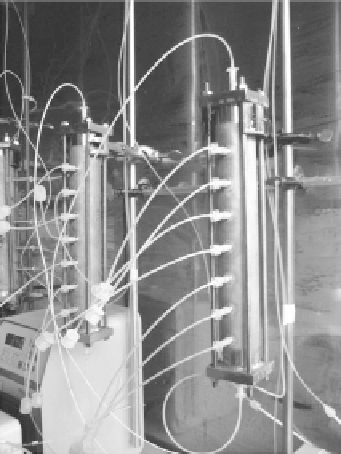Environmental Engineering Reference
In-Depth Information
11.2.4 Column Experiments
A number of column experiments were performed using artificial solutions
and real groundwater. Column experiments were performed with the acti-
vated carbon Epibon Y12×40 (Donau Carbon) in identical stainless-steel col-
umns with tubings made of teflon (PTFE) for influent, effluent, and sampling
ports (column diameter: 27.6 mm, length: 267 mm, see Figure 11.3).
Sieved (Fritsch Analysette 3 Pro with 1 mm sieve) activated carbon was
washed in an acrylic glass tube (10 × 100 cm) with a suitable flow of water from
the bottom to remove small particles. Columns were filled and packed with the
prepared wet-activated carbon. In addition, one column was used with 6.5%
(w/w) of activated carbon from the reactive barriers in Karlsruhe (Germany)
and Brunn am Gebirge (Austria) to establish a biocenosis. After filling each
column with 76 g of activated carbon, the columns were equilibrated in a
water bath for approximately 10 h with a gentle flow of water through the col-
umns. Numerous experiments were performed to characterize the activated-
carbon packing with the following results: d(corn)± σ = 1.0 ± 0.2 mm,
m(corn) ± σ = 0.77 ± 0.16 mg, ρ(corn) ± σ = 1.01 ± 0.15 g/cm, ρ(carbon parti-
cle): = 1.83 g/cm, ρ(bed) = 0.48 g/cm, ε(corn) = 0.44, and ε(bed) = 0.52.
Artificial mixtures and contaminated water from different wells at the
site Zeche Viktoria in Lünen (Germany) were used in column experiments.
Groundwater was obtained using a pump (MP-1, Grundfos, Germany) and
FIGURE 11.3
Two columns running in parallel to investigate breakthrough curves, adsorption ranking, and
the influence of biotic degradation of adsorbed compounds on activated carbon.

Search WWH ::

Custom Search